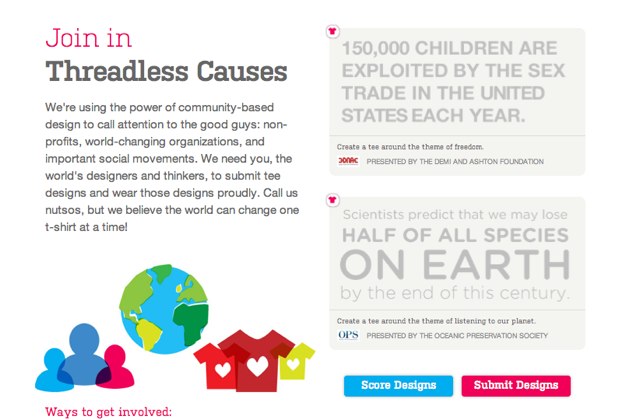
Threadless, one of the original crowdsourcing sites that pioneered the idea a decade ago and is now paying out more than $1 million a year in artist fees, is not just for T-shirts anymore. Today, the company is introducing a crowdsourcing platform called Threadless Atrium, which is initially targeted at causes and cause-based marketing campaigns. “Threadless Atrium will allow other organization to use community-based design to further their mission and causes,” says CEO Tom Ryan.
The first two examples of organizations using Atrium can be found on Threadless Causes. The DNA (Demi and Ashton) Foundation is using Threadless to solicit T-shirt designs to raise awareness about child sex slavery, and the Oceanic Preservation Society is crowdsourcing the artwork for its upcoming documentary Singing Planet about mass extinction. On the product side, Threadless is also working with fashion designer Steven Alan to come up with patterns for a future line of clothing which will also go towards helping DNA.
Threadless hosts and manages the crowdsourcing platform. and can manufacture any of the resulting products. In cases where Threadless manufactures the finished product, the causes get 25 percent of the retail value of anything sold. The causes or brands also take care of whatever the prize may be. Right now, causes and brands must submit an application to be hosted on Atrium, but eventually it will be self-serve. Threadless Atrium will also support widgets that can be embedded on other sites, as well as Facebook and iPhone apps.
The causes can tap into the 100,000 graphic designers and 3 million to 4 million monthly vistors who are already part the Threadless community The challenges don’t need to be T-shirt related, but for now Threadless is focussing on causes and cause-based marketing initiatives. “One thing is that it is very important is to present challenges that are inspirational to the creative community,” notes Ryan. “It lets the artists get excited about what they are designing.”
The key to making crowdsourcing successful is to make it personal, adds founder Jake Nickell. “I’ve seen a lot of crowdsourcing companies say, ‘I have this problem in my business let’s see the crowd solve it,'” he says. He doesn’t think that is the right approach, at least with artistic types. Better to see what activities and causes they are already rallying around and then give them a better way to express themselves.
Threadless has long been doing one-off Threadless Challenges for causes and brands, but it was having trouble keeping up with demand. So the company decided to build Atrium instead so that it could scale it s a new line of business. The platform is built from the ground up on an entirely new Web software stack that includes Django, MySQL and Amazon Web services—and theoretically could one day also power Threadless itself.

